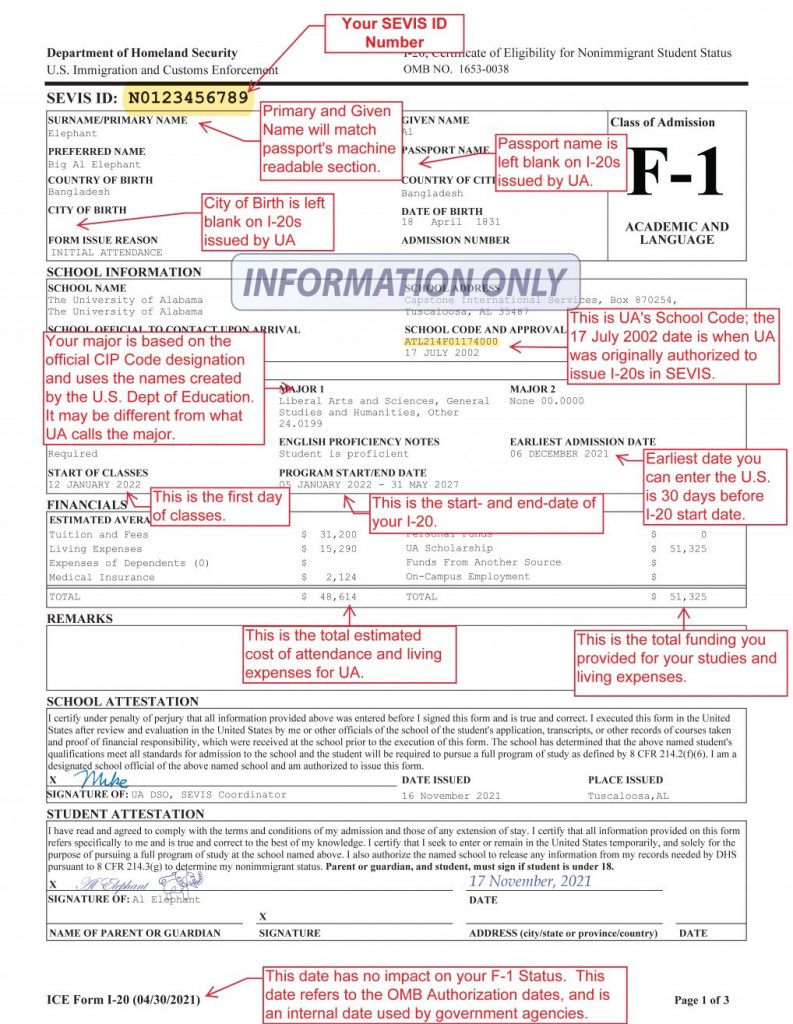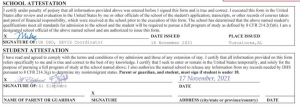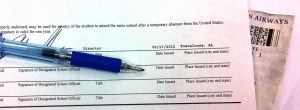
The image to the left is a sample F-1 I-20. To better understand each section, including the Personal and Biographical Information, School Information, Program of Study, Financials, and Attestations please see each section below.
- SEVIS ID
- PERSONAL AND BIOGRAPHICAL INFORMATION
- SCHOOL INFORMATION
- PROGRAM OF STUDY & PROGRAM START/END DATE INFORMATION
- FINANCIALS
- SCHOOL AND STUDENT ATTESTATIONS
- EMPLOYMENT AUTHORIZATIONS/EMPLOYER INFORMATION (PAGE 2 OF I-20)
- TRAVEL ENDORSEMENT SIGNATURES (PAGE 2 OF I-20)
Note: The Form I-20 is updated with minor revisions periodically. Your actual I-20 may differ slightly from the sample included, but the main sections should be the same.
The version of the Form I-20 is noted in the bottom left corner of Page 1 of the I-20. The date listed on the Form I-20 version has no impact on a student visa status.
SEVIS ID
Your SEVIS ID number is printed at the top of the form and has the format “N0xxxxxxxxx“. It is a unique identifier that matches your SEVIS database record.

PERSONAL AND BIOGRAPHICAL INFORMATION

You should make sure that your personal and biographical information are correct.
-
Your surname and given name should match your name as printed in your passport (these will match the naming as it is listed in the Machine Readable Zone at the bottom of the passport, using the SEVIS Naming Standards).
-
If your name on your passport uses any special characters or marks, this can be included in the Preferred Name section.
-
Your country of birth, country of citizenship, and date of birth should be correct.
Non-required Fields (UA does not enter this information on the I-20):
-
The passport name field does not need to be filled out and will be left blank.
-
The city of birth field does not need to be filled out and will be left blank.
-
The admission number is no longer filled out and will be blank.
Form Issuance Reasons:
-
The form issuance reason for new students will usually be “initial attendance” for your first I-20, and “continued attendance” after you arrive in the US, and only if your I-20 is later updated with new information
-
The form issuance reason may also indicate “transfer pending” if you have finished your studies at one school and are waiting to start your program at another school
-
There may be other reasons indicated – contact International Student & Scholar Services if you have any questions.
SCHOOL INFORMATION
The school information section indicates your school’s name, reporting address, the name of the international student advisor (“Designated School Official”) who issued the I-20, and The University of Alabama’s SEVP School Code: ATL214F01174000.

PROGRAM OF STUDY & PROGRAM START/END DATE INFORMATION

The Program of Study section includes:
-
Your education level (e.g., bachelor’s, master’s, doctorate, etc.)
-
Your major(s) – note that the major listed on the I-20 may not be exactly the same as your official University of Alabama major. This is because the I-20 reflects a list of majors drawn from the U.S. Department of Education’s CIP Code Lists, and this is used by the Department of Homeland Security for the I-20. The name of the major on the I-20 is not determined by UA. The US government’s major listed on your I-20 is the “closest match” to your actual UA major. UA’s majors and affiliated CIP Codes may be found on the Office of Institutional Effectiveness site.
-
Your program start and end dates – the program start and end dates reflect the anticipated start to your program (this is the report date, which is generally set 1 week before the first day of classes to allow students to attend orientation) and the end date to your program (the last day of your anticipated final semester or term). See below for more information.
-
Start of classes date – This is the first day of classes for your initial semester of study in the program.
-
Earliest admission date – This is the earliest date you may enter the U.S., which is 30 days prior to the program start date.
Program Start / End Date and Program Length
It is important to understand your program start and end date information. Every I-20 includes an average estimate of the amount of time it takes to complete the program.
-
Length of program dates – In general, all UA I-20s are issued for the estimated program length most common to the degree category, as follows:
-
bachelor’s degree I-20s are issued for 5 years (i.e. 10 semesters)
-
master’s degree I-20s are issued for 2 years (i.e. 4 semesters)
-
JD (Law) degree I-20s are issued for 3 years (i.e. 6 semesters)
-
MFA degree I-20s are issued for 4 years (i.e. 8 semesters)
- doctoral degree I-20s are issued for 5 1/2 years (i.e. 11 semesters)
-
-
Under F-1 visa rules, you are permitted to arrive in the US no earlier than 30 days before the program start date on your I-20. (See “Earliest admission date” above.)
-
Once the program end date is reached, and you have finished your program, you have a 60-day Grace Period to depart the U.S. or take other action. See our section on Grace Periods.
-
If you need more time to complete your program requirements, you must submit a request to International Student & Scholar Services for an F-1 program extension BEFORE the I-20 program end date is reached.
-
If you complete your program (or stop studying) before the program end date, contact International Student & Scholar Services to update your SEVIS record.
FINANCIALS

The financials section of the I-20 includes the estimate of expenses for your program and a description of the financial resources you showed when applying for your I-20. Your financial resources can include a combination of personal or family funds, scholarships, fellowships, or other resources.
We outline our current estimate of tuition and fees, living expenses, dependent expenses and other expenses on our Required Funding & Estimated Expenses page.
You must submit new financial documents if you apply for an I-20 extension (see F-1 Program Extension) or F-1 reinstatement.
The financial information on an I-20 is always an estimate of your educational expenses. Actual expenses may vary from student to student and program to program. However, the information on the I-20 should provide a reasonable indication of the likely costs for a full-time student in your program.
SCHOOL AND STUDENT ATTESTATIONS
At the bottom of page 1 of your I-20, your international student advisor will sign the School Attestation section of the form. You are also required to read the Student Attestation section and should sign the form to indicate your agreement to the terms outlined on the I-20.

EMPLOYMENT AUTHORIZATIONS/EMPLOYER INFORMATION (PAGE 2 OF I-20)
While pursuing studies as an F-1 student, if you are authorized by ISSS to pursue employment options such as Curricular Practical Training (CPT) or Optional Practical Training (OPT), your SEVIS record will be updated and a new I-20 will be issued to you. The updated I-20 will have the type of employment authorization (e.g., CPT or OPT), the dates of the work authorization, and the name and location of your employer (if required).
TRAVEL ENDORSEMENT SIGNATURES (PAGE 2 OF I-20)

The travel endorsement section (or travel signature section) of the I-20 is signed by your international student advisor, usually once a year. By signing the form, the advisor is confirming that you are attending school, maintaining valid F-1 status, and are eligible to return to The University of Alabama after a trip abroad. When you return, the U.S. Customs and Border Protection officer will look to see that your I-20 has been signed by an international advisor.
NOTE FOR INITIAL ATTENDANCE I-20s: The travel endorsement section only needs to be signed after you arrive in the U.S. and register with UA as an F-1 student. After that point, the travel endorsement confirms your arrival and status as an F-1 student in good standing.
Only International Student & Scholar Services staff can sign Form I-20 for UA students – do not request travel signatures from your academic advisors or professors / instructors.
-
The travel signature should be no more than one year old at the time of your return to the US. You do not need a travel signature if you are not traveling outside the US or if you have completed your program and are simply leaving the U.S. permanently.
-
If you are on post-completion Optional Practical Training, the travel signature should be no more than six months old on the date of your return.
To learn more about obtaining travel as an F-1 student, refer to the Student Travel Requirements page.
